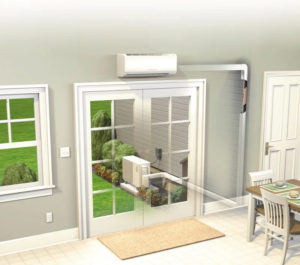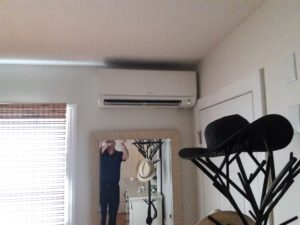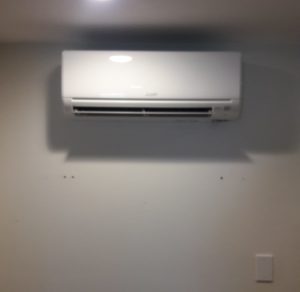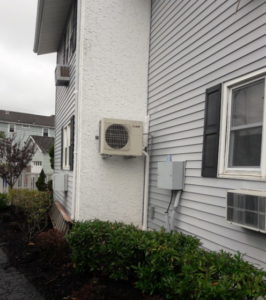Mini split updates heating and cooling in Ocean City, NJ condo
July 26, 2019

Baseboard heat and window air conditioners used to be go-to’s for condos in Ocean City, NJ, and other Jersey shore points. Now, Mitsubishi mini splits can handle both heating and cooling under the same circumstances. And, they do a better job while using less energy.
Our condo owner called Broadley’s when he was ready to upgrade his HVAC system. But, he knew there would be some challenges.
For starters, there wasn’t an opportunity for gas heating in his neighborhood. That’s why he had electric baseboard heaters in the first place.
 Meanwhile, his home didn’t have ductwork. That ruled out central air. Unless, of course, he wanted to spend a few thousand extra on ducts that would cut down on his living space.
For a long time, there weren’t many good options for upgrading in a situation like this. But, ductless heating and cooling has changed all that.
This case study is a great opportunity for us to explore how Mitsubishi mini splits:
Meanwhile, his home didn’t have ductwork. That ruled out central air. Unless, of course, he wanted to spend a few thousand extra on ducts that would cut down on his living space.
For a long time, there weren’t many good options for upgrading in a situation like this. But, ductless heating and cooling has changed all that.
This case study is a great opportunity for us to explore how Mitsubishi mini splits:
Problem: A condo owner in Ocean City, NJ wanted to replace old baseboard heat. But, gas heat was not available. The condo also had old window air conditioners. Solution: Installed a Mitsubishi mini split system with an outdoor heat pump and two indoor air handlers. The system provides both heating and cooling for the entire condo.
 It’s no surprise our condo owner was ready for an upgrade. For a while, baseboard heat seemed like the way to go here. Gas heat isn’t an option in this neighborhood.
But, that didn’t make this a perfect solution. Baseboards generate very dry heat. Many people couple them with humidifiers.
Meanwhile, baseboard heat uses more energy than a mini split. Blame that, in large part, on outdated technology.
Similarly, those old setups don’t do nearly as good of a job of circulating the air. It takes longer to warm up a room and keep it at the temperature you want.
Now, let’s look at how ductless does it better.
It’s no surprise our condo owner was ready for an upgrade. For a while, baseboard heat seemed like the way to go here. Gas heat isn’t an option in this neighborhood.
But, that didn’t make this a perfect solution. Baseboards generate very dry heat. Many people couple them with humidifiers.
Meanwhile, baseboard heat uses more energy than a mini split. Blame that, in large part, on outdated technology.
Similarly, those old setups don’t do nearly as good of a job of circulating the air. It takes longer to warm up a room and keep it at the temperature you want.
Now, let’s look at how ductless does it better.
 However, they do a great job of moving the air around. So, we can install them in out-of-the-way places.
The most popular types – like the ones we used in this condo – are called “high wall” air handlers. We mount them near the ceiling, and often in a corner.
Each head has a thermostat. So, it can treat one area of the home individually. This feature comes in handy when one or two rooms are always warmer or colder than the others.
And, each one uses Inverter technology to keep costs down. Unlike baseboard or most forced heat setups, they don’t just kick on when the temperature dips.
Instead, they run in low-power mode most of the time. That keeps the temperature consistent. This process uses less energy and causes less wear and tear on the unit.
Now that we’ve covered heating, how does it fare with cooling?
However, they do a great job of moving the air around. So, we can install them in out-of-the-way places.
The most popular types – like the ones we used in this condo – are called “high wall” air handlers. We mount them near the ceiling, and often in a corner.
Each head has a thermostat. So, it can treat one area of the home individually. This feature comes in handy when one or two rooms are always warmer or colder than the others.
And, each one uses Inverter technology to keep costs down. Unlike baseboard or most forced heat setups, they don’t just kick on when the temperature dips.
Instead, they run in low-power mode most of the time. That keeps the temperature consistent. This process uses less energy and causes less wear and tear on the unit.
Now that we’ve covered heating, how does it fare with cooling?
 Ductless works the same way in AC mode as it does with heating. As a result, mini splits are much more efficient than old window air conditioning units. They do the job better and use less energy to do it. They’re also much quieter.
The same heat transfer process is in play here. The system just works in reverse during the summer.
The air handlers draw warm air from inside the home. They dehumidify the air as part of the cooling process and remove the heat using a refrigerant liquid inside the system.
That liquid then transfers the thermal heat to the outdoor unit.
Back in the home, the heads circulate the now-cooled air.
Ductless works the same way in AC mode as it does with heating. As a result, mini splits are much more efficient than old window air conditioning units. They do the job better and use less energy to do it. They’re also much quieter.
The same heat transfer process is in play here. The system just works in reverse during the summer.
The air handlers draw warm air from inside the home. They dehumidify the air as part of the cooling process and remove the heat using a refrigerant liquid inside the system.
That liquid then transfers the thermal heat to the outdoor unit.
Back in the home, the heads circulate the now-cooled air.
 Once again, this process uses much less electricity with a Mitsubishi system than window AC’s. That means much lower electric bills when it’s warm out.
And, there’s another significant advantage over those old units: Sound – or a lack thereof.
Mitsubishi mini split systems are whisper-quiet. The most noise they make is as soft as leaves rustling outside.
Unless you’re standing right underneath one, and it’s silent in the room, and it’s on full blast, you won’t hear a thing. Even in that situation, it barely makes a sound.
These benefits made a ductless system the obvious choice for this condo owner. Now, let’s look at his installation.
Once again, this process uses much less electricity with a Mitsubishi system than window AC’s. That means much lower electric bills when it’s warm out.
And, there’s another significant advantage over those old units: Sound – or a lack thereof.
Mitsubishi mini split systems are whisper-quiet. The most noise they make is as soft as leaves rustling outside.
Unless you’re standing right underneath one, and it’s silent in the room, and it’s on full blast, you won’t hear a thing. Even in that situation, it barely makes a sound.
These benefits made a ductless system the obvious choice for this condo owner. Now, let’s look at his installation.
 Each handler covered a different “zone” in the condo. The one in the living room heated and cooled the common areas. Then, another in the hallway took care of the bedrooms.
Each handler covered a different “zone” in the condo. The one in the living room heated and cooled the common areas. Then, another in the hallway took care of the bedrooms.
 With that all set, we had to make a plan to connect the indoor and outdoor units.
We mentioned the refrigerant line before. Well, that’s one of three lines we run from the heads. The other two are a power line and a condensate line. That last line drains the water that condenses from water vapor when the system cools the air.
The good news is that these lines aren’t that big. Even when we bundle them all together, the whole line set is around three inches in diameter.
With that all set, we had to make a plan to connect the indoor and outdoor units.
We mentioned the refrigerant line before. Well, that’s one of three lines we run from the heads. The other two are a power line and a condensate line. That last line drains the water that condenses from water vapor when the system cools the air.
The good news is that these lines aren’t that big. Even when we bundle them all together, the whole line set is around three inches in diameter.
 You can see where the line set casing comes out of the wall and connects to the outdoor unit. That’s what we ran behind the walls inside.
After that, there was nothing to do but to turn on the system and let our condo owner enjoy his quiet, efficient air conditioning.
And, when the temperature dips in a few months, he’ll turn it on again and get better heat and air quality with lower electric bills.
Are you ready to upgrade from baseboard heat and window air conditioners? Let Broadley’s help you take care of both at once! With a free consultation, we’ll help you find the system that’s perfect for your condo.
You can see where the line set casing comes out of the wall and connects to the outdoor unit. That’s what we ran behind the walls inside.
After that, there was nothing to do but to turn on the system and let our condo owner enjoy his quiet, efficient air conditioning.
And, when the temperature dips in a few months, he’ll turn it on again and get better heat and air quality with lower electric bills.
Are you ready to upgrade from baseboard heat and window air conditioners? Let Broadley’s help you take care of both at once! With a free consultation, we’ll help you find the system that’s perfect for your condo.
 Meanwhile, his home didn’t have ductwork. That ruled out central air. Unless, of course, he wanted to spend a few thousand extra on ducts that would cut down on his living space.
For a long time, there weren’t many good options for upgrading in a situation like this. But, ductless heating and cooling has changed all that.
This case study is a great opportunity for us to explore how Mitsubishi mini splits:
Meanwhile, his home didn’t have ductwork. That ruled out central air. Unless, of course, he wanted to spend a few thousand extra on ducts that would cut down on his living space.
For a long time, there weren’t many good options for upgrading in a situation like this. But, ductless heating and cooling has changed all that.
This case study is a great opportunity for us to explore how Mitsubishi mini splits:
- Offer heating vs. electric baseboards
- Out-perform window air conditioners
- Are easy to install and customize
Problem: A condo owner in Ocean City, NJ wanted to replace old baseboard heat. But, gas heat was not available. The condo also had old window air conditioners. Solution: Installed a Mitsubishi mini split system with an outdoor heat pump and two indoor air handlers. The system provides both heating and cooling for the entire condo.
Ductless vs. baseboard heat
Compared to baseboard heat, a ductless mini split:- Improves air quality
- Costs less to run
- Offers better warmth
 It’s no surprise our condo owner was ready for an upgrade. For a while, baseboard heat seemed like the way to go here. Gas heat isn’t an option in this neighborhood.
But, that didn’t make this a perfect solution. Baseboards generate very dry heat. Many people couple them with humidifiers.
Meanwhile, baseboard heat uses more energy than a mini split. Blame that, in large part, on outdated technology.
Similarly, those old setups don’t do nearly as good of a job of circulating the air. It takes longer to warm up a room and keep it at the temperature you want.
Now, let’s look at how ductless does it better.
It’s no surprise our condo owner was ready for an upgrade. For a while, baseboard heat seemed like the way to go here. Gas heat isn’t an option in this neighborhood.
But, that didn’t make this a perfect solution. Baseboards generate very dry heat. Many people couple them with humidifiers.
Meanwhile, baseboard heat uses more energy than a mini split. Blame that, in large part, on outdated technology.
Similarly, those old setups don’t do nearly as good of a job of circulating the air. It takes longer to warm up a room and keep it at the temperature you want.
Now, let’s look at how ductless does it better.
How Mitsubishi mini splits work
Mini splits use a heat transfer process. In the colder months, an outdoor heat pump uses what little heat there is outside. It amplifies that warmth and sends it inside. As long as it’s warmer than negative 13 degrees Fahrenheit, the system has all the thermal energy it needs. Inside the condo, the air handlers, or heads, circulate that warm air. These units are mounted on the walls wherever they’re needed. However, they do a great job of moving the air around. So, we can install them in out-of-the-way places.
The most popular types – like the ones we used in this condo – are called “high wall” air handlers. We mount them near the ceiling, and often in a corner.
Each head has a thermostat. So, it can treat one area of the home individually. This feature comes in handy when one or two rooms are always warmer or colder than the others.
And, each one uses Inverter technology to keep costs down. Unlike baseboard or most forced heat setups, they don’t just kick on when the temperature dips.
Instead, they run in low-power mode most of the time. That keeps the temperature consistent. This process uses less energy and causes less wear and tear on the unit.
Now that we’ve covered heating, how does it fare with cooling?
However, they do a great job of moving the air around. So, we can install them in out-of-the-way places.
The most popular types – like the ones we used in this condo – are called “high wall” air handlers. We mount them near the ceiling, and often in a corner.
Each head has a thermostat. So, it can treat one area of the home individually. This feature comes in handy when one or two rooms are always warmer or colder than the others.
And, each one uses Inverter technology to keep costs down. Unlike baseboard or most forced heat setups, they don’t just kick on when the temperature dips.
Instead, they run in low-power mode most of the time. That keeps the temperature consistent. This process uses less energy and causes less wear and tear on the unit.
Now that we’ve covered heating, how does it fare with cooling?
Window Units vs. Ductless AC
 Ductless works the same way in AC mode as it does with heating. As a result, mini splits are much more efficient than old window air conditioning units. They do the job better and use less energy to do it. They’re also much quieter.
The same heat transfer process is in play here. The system just works in reverse during the summer.
The air handlers draw warm air from inside the home. They dehumidify the air as part of the cooling process and remove the heat using a refrigerant liquid inside the system.
That liquid then transfers the thermal heat to the outdoor unit.
Back in the home, the heads circulate the now-cooled air.
Ductless works the same way in AC mode as it does with heating. As a result, mini splits are much more efficient than old window air conditioning units. They do the job better and use less energy to do it. They’re also much quieter.
The same heat transfer process is in play here. The system just works in reverse during the summer.
The air handlers draw warm air from inside the home. They dehumidify the air as part of the cooling process and remove the heat using a refrigerant liquid inside the system.
That liquid then transfers the thermal heat to the outdoor unit.
Back in the home, the heads circulate the now-cooled air.
 Once again, this process uses much less electricity with a Mitsubishi system than window AC’s. That means much lower electric bills when it’s warm out.
And, there’s another significant advantage over those old units: Sound – or a lack thereof.
Mitsubishi mini split systems are whisper-quiet. The most noise they make is as soft as leaves rustling outside.
Unless you’re standing right underneath one, and it’s silent in the room, and it’s on full blast, you won’t hear a thing. Even in that situation, it barely makes a sound.
These benefits made a ductless system the obvious choice for this condo owner. Now, let’s look at his installation.
Once again, this process uses much less electricity with a Mitsubishi system than window AC’s. That means much lower electric bills when it’s warm out.
And, there’s another significant advantage over those old units: Sound – or a lack thereof.
Mitsubishi mini split systems are whisper-quiet. The most noise they make is as soft as leaves rustling outside.
Unless you’re standing right underneath one, and it’s silent in the room, and it’s on full blast, you won’t hear a thing. Even in that situation, it barely makes a sound.
These benefits made a ductless system the obvious choice for this condo owner. Now, let’s look at his installation.
Installing a Mitsubishi mini split in an Ocean City, NJ condo
For this condo, we recommended a two head unit with one heat pump. That means there are two air handlers inside the house connecting to a single outside unit. Each handler covered a different “zone” in the condo. The one in the living room heated and cooled the common areas. Then, another in the hallway took care of the bedrooms.
Each handler covered a different “zone” in the condo. The one in the living room heated and cooled the common areas. Then, another in the hallway took care of the bedrooms.
 With that all set, we had to make a plan to connect the indoor and outdoor units.
We mentioned the refrigerant line before. Well, that’s one of three lines we run from the heads. The other two are a power line and a condensate line. That last line drains the water that condenses from water vapor when the system cools the air.
The good news is that these lines aren’t that big. Even when we bundle them all together, the whole line set is around three inches in diameter.
With that all set, we had to make a plan to connect the indoor and outdoor units.
We mentioned the refrigerant line before. Well, that’s one of three lines we run from the heads. The other two are a power line and a condensate line. That last line drains the water that condenses from water vapor when the system cools the air.
The good news is that these lines aren’t that big. Even when we bundle them all together, the whole line set is around three inches in diameter.
Running lines to the heat pump outside
In a condo such as this, it’s easy to simply run the line set behind the walls and then outside to the heat pump. The only consideration here is that the condensate line should slope down rather than run in a straight line or up. This way, the water drains naturally using gravity. However, that’s easy enough to do. And, to save space, we mounted the heat pump on the stucco wall on the outside of the house. You can see where the line set casing comes out of the wall and connects to the outdoor unit. That’s what we ran behind the walls inside.
After that, there was nothing to do but to turn on the system and let our condo owner enjoy his quiet, efficient air conditioning.
And, when the temperature dips in a few months, he’ll turn it on again and get better heat and air quality with lower electric bills.
Are you ready to upgrade from baseboard heat and window air conditioners? Let Broadley’s help you take care of both at once! With a free consultation, we’ll help you find the system that’s perfect for your condo.
You can see where the line set casing comes out of the wall and connects to the outdoor unit. That’s what we ran behind the walls inside.
After that, there was nothing to do but to turn on the system and let our condo owner enjoy his quiet, efficient air conditioning.
And, when the temperature dips in a few months, he’ll turn it on again and get better heat and air quality with lower electric bills.
Are you ready to upgrade from baseboard heat and window air conditioners? Let Broadley’s help you take care of both at once! With a free consultation, we’ll help you find the system that’s perfect for your condo.
Read More of Our Articles
View other Home Improvement, Energy Efficiency, Ductless Education, Air Conditioning, Heating articles.
